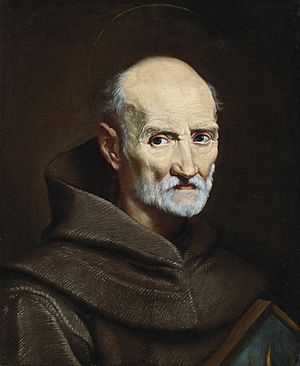Luke Wadding facts for kids
Quick facts for kids Luke Wadding |
|
|---|---|

|
|
| Order | Franciscan |
| Philosophy | Scotism |
| Known for | Annales Minorum |
| Alma mater | University of Coimbra |
| Personal | |
| Nationality | Irish |
| Born | 16 October 1588 Waterford, Kingdom of Ireland |
| Died | 18 November 1657 (aged 69) Rome, Papal States |
| Resting place | Sant'Isidoro a Capo le Case |
| Parents | Walter Wadding and Anastasia Wadding (née Lombard) |
Luke Wadding (born October 16, 1588 – died November 18, 1657) was an Irish Franciscan friar and an important historian. He is known for his major work, Annales Minorum, which is a history of the Franciscan Order. He also played a big role in establishing St Patrick's Day as a special holiday.
Contents
Life of Luke Wadding
Early Years
Luke Wadding was born in Waterford, Ireland, on October 16, 1588. His father, Walter Wadding, was a successful merchant. His mother, Anastasia Lombard, was the sister of Peter Lombard, Archbishop of Armagh, a very important church leader.
Luke went to school in Waterford and Kilkenny. In 1604, he traveled to Lisbon, Portugal, to continue his studies. He also attended the University of Coimbra.
Becoming a Franciscan Friar
After finishing his university studies, Luke Wadding decided to become a Franciscan friar in 1607. He spent time learning about the Franciscan way of life in Portugal. In 1613, he became a priest.
Later, in 1617, he became the head of the Irish College at the University of Salamanca in Spain. He also taught theology there.
Founding St. Isidore's College
In 1618, Luke Wadding moved to Rome, Italy. He worked as a chaplain for the Spanish ambassador. While in Rome, he worked hard to raise money to build a new college. This college, called the College of St. Isidore, opened in 1625. It was created to educate Irish priests.
Wadding gave the college a huge library. It had 5,000 printed books and 800 old manuscripts. He was the head of the college for 15 years. From 1630 to 1634, he also served as a leader for the Franciscan Order in Rome.
Influence in the Church
Luke Wadding was so respected that he even received votes to become Pope during two elections in 1644 and 1655. This shows how close he came to being the first Irish Pope!
He was a strong supporter of Irish Catholics during a time of conflict in Ireland. His college in Rome became a voice for the Irish cause. He even helped send supplies and support to Ireland.
The Irish Catholics asked Pope Urban VIII to make Wadding a cardinal, which is a very high rank in the Catholic Church. However, Wadding humbly stopped the request himself.
Luke Wadding also loved art. He asked famous painters like Andrea Sacchi and Carlo Maratti to create artworks for St. Isidore's church in Rome.
Death
Luke Wadding passed away on November 18, 1657, when he was 69 years old. He is buried in the church of the College of San Isidore in Rome. His nephew, Francis Harold, wrote a book about his life.
Legacy and Impact
St. Patrick's Day
Thanks to Luke Wadding's efforts, St Patrick's Day became an official feast day for the Catholic Church. While it took many years for parades to become common in Ireland, the first organized celebrations in America happened much earlier. Today, St. Patrick's Day is celebrated all over the world!
Scholarly Work
Wadding also founded the Pontifical Irish College for Irish priests. He was a very important scholar. He helped create a major collection of the works of Duns Scotus, a famous philosopher. This collection, known as the Wadding Edition, was very important for scholars for many years.
Statues and Buildings
In the 1950s, a statue of Luke Wadding was placed in his hometown of Waterford. It showed him holding a quill pen, representing his writing and studies. This statue was later moved to the entrance of the French Church, Waterford.
In 2000, the Waterford Institute of Technology named its new library building after him.
Works
Luke Wadding was a very productive writer. He published 36 books in total. His most famous work is the Annales Minorum. This huge history book, published in eight volumes, tells the story of the Franciscan Order.
He also published a list of Franciscan writers and edited the works of Duns Scotus. He even put together the first collection of the writings of St Francis of Assisi, the founder of the Franciscan Order.
Some of his important works include:
- Annales Minorum (1625–54) – a history of the Franciscan Order.
- Duns Scotus (1639) – a collection of the philosopher's works.
- πρεσβεία [Presbeia] (1624) – a book about the Immaculate Conception of the Virgin Mary.
- De Hebraicæ origine, præstantia, et utilitate (1621) – an essay about the Hebrew language.
Images for kids
-
Carlo Maratta, Luke Wadding (National Gallery of Ireland, Dublin)
See also
- Michael Wadding (priest)
- List of people on stamps of Ireland


